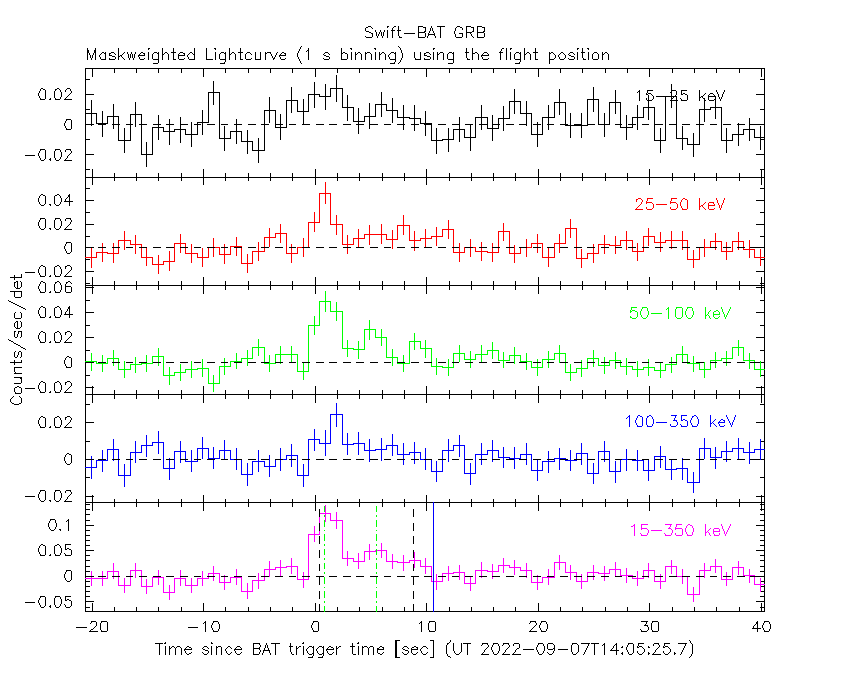
K.L. Page (U. Leicester) and S.R. Oates (U. Birmingham) for the Swift team
At 14:05:25 UT, the Swift Burst Alert Telescope (BAT) triggered and located GRB 220907A (trigger=1123129) (Page et al. GCN Circ. 32526). Swift slewed immediately to the burst. At the time of the trigger, the initial BAT position was 104° from the Sun (6.9 hours East) and 38° from the 89%-illuminated Moon. Table 1 contains the best reported positions from Swift, and the latest XRT position can be viewed at http://www.swift.ac.uk/xrt_positions.
Table 2 is a summary of GCN Circulars about this GRB from observatories other than Swift.
Standard analysis products for this burst are available at https://gcn.gsfc.nasa.gov/swift_gnd_ana.html.
The partial coding was 90%.
The mask-weighted light curve (Figure 1) shows a single peak of ten seconds approximate
duration starting at T-1 s.
A spacecraft maneuver took the source out of the BAT
field of view at approximately 400 seconds.
The results of the batgrbproduct analysis are available at https://gcn.gsfc.nasa.gov/notices_s/1123129/BA/.
Analysis of the initial XRT data was reported by Page (GCN Circ. 32530).
We have analysed 5.6 ks of XRT data for GRB 220907A, from 100 s to 21.5 ks after the BAT trigger. The data are entirely in Photon Counting (PC) mode. The source is fading with α >0.4.
The results of the XRT team automatic analysis are available at http://www.swift.ac.uk/xrt_products/01123129.
The Swift/UVOT began settled observations of the field of GRB 220907A 95 s after the BAT trigger
(Oates and Page GCN Circ. 32531).
No optical afterglow consistent with the enhanced XRT position (Page and Evans GCN Circ. 32530) is detected in the initial UVOT exposures.
Table 3 gives preliminary
magnitudes using the UVOT photometric system
(Breeveld et al. 2011, AIP Conf. Proc., 1358, 373).
No correction has been made for the expected extinction in the Milky Way
corresponding to a reddening of

Figure 1. The BAT
mask-weighted light curve in the four individual and total
energy bands. The units are counts

Figure 2. The XRT light curve.
Any data from a crosshatched region are not included in the fit.
| RA (J2000) | Dec (J2000) | Error | Note | Reference |
|---|---|---|---|---|
| 1 |
-20°17'22.2" | 4.0" | XRT-final | UKSSDC |
| 1 |
-20°17'22.2" | 4.0" | XRT-refined | Page GCN Circ. 32530 |
| 1 |
-20°18'10.8" | 1.9' | BAT-refined | Stamatikos et al. GCN Circ. 32537 |
| Band | Authors | GCN Circ. | Subject | Observatory | Notes |
|---|---|---|---|---|---|
| Optical | Lipunov et al. | 32524 | Swift GRB220907.59: Global MASTER-Net observations report |
MASTER | |
| Optical | Zhu et al. | 32532 | Nanshan/NEXT optical upper limits | Xinjiang Astro. Obs. | upper limits |
| Gamma-ray | Fermi | 32525 | Fermi GBM Final Real-time Localization | Fermi GBM | |
| Gamma-ray | Dalessi et al. | 32533 | Fermi GBM observation | Fermi GBM | Fluence=1.13±0.12x1 (brighter than 17% of long GRBs) |
| Filter | Exp(s) | Mag | ||
|---|---|---|---|---|
| whit |
95 | 245 | 147 | >20.2 |
| white | 95 | 5001 | 298 | >20.6 |
| v | 3823 | 4023 | 197 | >18.6 |
| b | 4644 | 4844 | 197 | >19.7 |
| u | 4438 | 4638 | 197 | >19.4 |
| w1 | 4234 | 4433 | 197 | >19.2 |
| m2 | 4028 | 4228 | 197 | >19.2 |
| w2 | 3618 | 3818 | 197 | >19.2 |
Table 3. UVOT observations reported by Oates and Page (GCN Circ. 32531). The start and stop times of the exposures are given in seconds since the BAT trigger. The preliminary 3-σ upper limits are given. No correction has been made for extinction in the Milky Way.
September 9, 2022